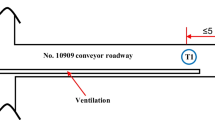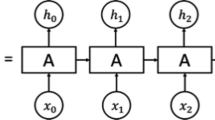Abstract
Underground coal gasification (UCG) is a serious attempt to clean and efficient use of coal, but it has not been able to solve the problem of stable production. Predicting UCG can provide effective guidance for control, which effectively solves this problem. Existing UCG prediction models are not accurate, and most of them can only predict a single variable, and cannot adequately predict the UCG state. The paper proposes the concept of combustible gas equivalents that can characterize the concentration of mixed gas through stoichiometry and material balance equations. The equivalent gradient is introduced to characterize the trends in equivalent, and the UCG state discrimination standard is established to evaluate the UCG state. Eventually, a dual-source long short-term memory (LSTM) prediction model is proposed for predicting UCG state. The experimental results show that compared with Support Vector Machine (SVM) and Back Propagation Neural Network (BPNN) prediction model, the model can make a better prediction of equivalent value and the accuracy of predicting trends in equivalent reaches 90.99%.




Similar content being viewed by others
References
Thomas DJ (2016) Direct underground gasification of North Sea coal for future UK energy prosperity. Fuel 185:941–941. https://doi.org/10.1016/j.fuel.2016.08.032
Verma A, Olateju B, Kumar A (2015) Greenhouse gas abatement costs of hydrogen production from underground coal gasification. Energy 85:556–568. https://doi.org/10.1016/j.energy.2015.03.070
Imran M, Kumar D, Kumar N, Qayyum A, Saeed A, Bhatti MS (2014) Environmental concerns of underground coal gasification. Renew Sust Energ Rev 31:600–610. https://doi.org/10.1016/j.rser.2013.12.024
Bhutto AW, Bazmi AA, Zahedi G (2013) Underground coal gasification: from fundamentals to applications. Prog Energ Combust 39(1):189–214. https://doi.org/10.1016/j.pecs.2012.09.004
Green M (2018) Recent developments and current position of underground coal gasification. P I Mech Eng A-J Pow 232(1):39–46. https://doi.org/10.1177/0957650917718772
Su FQ, Itakura K, Deguchi G, Ohga K (2017) Monitoring of coal fracturing in underground coal gasification by acoustic emission techniques. Appl Energ 189:142–156. https://doi.org/10.1016/j.apenergy.2016.11.082
Perkins G (2018) Underground coal gasification—Part II: Fundamental phenomena and modeling. Prog Energ Combust 67:234–274. https://doi.org/10.1016/j.pecs.2018.03.002
Perkins G (2018) Underground coal gasification—Part I: Field demonstrations and process performance. Prog Energ Combust 67:158–187. https://doi.org/10.1016/j.pecs.2018.02.004
Xiao YT, Yin JH, Hu YF, Wang JZ, Yin HS, Qi HG (2019) Monitoring and control in underground coal gasification: current research status and future perspective. Sustainability. https://doi.org/10.3390/su11010217
Su FQ, Hamanaka A, Itakura K, Zhang WY, Deguchi G, Sato K, Takahashi K, Kodama J (2018) Monitoring and evaluation of simulated underground coal gasification in an ex-situ experimental artificial coal seam system. Appl Energ 223:82–92. https://doi.org/10.1016/j.apenergy.2018.04.045
Laciak M, Kostur K, Durdan M, Kacur J, Flegner P (2016) The analysis of the underground coal gasification in experimental equipment. Energy 114:332–343. https://doi.org/10.1016/j.energy.2016.08.004
Khan MM, Mmbaga JP, Shirazi AS, Trivedi J, Liu Q, Gupta R (2015) Modelling underground coal gasification—a review. Energies 8(11):12603–12668. https://doi.org/10.3390/en81112331
Guo R, Guo W, Hu H (2008) Texaco coal gasification quality prediction by neural estimator based on MSA and dynamic PCA. In: IEEE International Conference on Automation and Logistics, pp 2241–2246
Krzemien A (2019) Dynamic fire risk prevention strategy in underground coal gasification processes by means of Artifical Neural Networks. Arch Min Sci 64(1):3–19. https://doi.org/10.24425/ams.2018.124991
Dufaux A, Gaveau B, Létolle R, Mostade M, Noël M, Pirard JP (1990) Modelling of the underground coal gasification process at Thulin on the basis of thermodynamic equilibria and isotopic measurements. Fuel 69(5):624–632. https://doi.org/10.1016/0016-2361(90)90149-K
Laciak M, Kacur J, Kostur K (2016) The verification of thermodynamic model for UCG process. In: 17th IEEE International Carpathian Control Conference, pp 424–428
Eftekhari AA, Wolf KH, Rogut J, Bruining H (2015) Mathematical modeling of alternating injection of oxygen and steam in underground coal gasification. Int J Coal Geo 150:154–165. https://doi.org/10.1016/j.coal.2015.08.008
Eftekhari AA, Wolf KH, Rogut J, Bruining H (2017) Energy and exergy analysis of alternating injection of oxygen and steam in the low emission underground gasification of deep thin coal. Appl Energ 208:62–71. https://doi.org/10.1016/j.apenergy.2017.10.063
Kaur J, Laciak M, Durdan M, Flegner P(2017) Utilization of Machine Learning method in prediction of UCG data. In: 18th International Carpathian Control Conference, pp 278–283
Krzemien A (2019) Fire risk prevention in underground coal gasification (UCG) within active mines: temperature forecast by means of MARS models. Energy 170:777–790. https://doi.org/10.1016/j.energy.2018.12.179
Prabu V, Jayanti S (2011) Simulation of cavity formation in underground coal gasification using bore hole combustion experiments. Energy 36(10):5854–5864. https://doi.org/10.1016/j.energy.2011.08.037
Duan TH, Lu CP, Xiong S, Fu ZB, Zhang B (2016) Evaluation method of the energy conversion efficiency of coal gasification and related applications. Int J Energ Res 40(2):168–180. https://doi.org/10.1002/er.3444
Su FQ, Itakura KI, Deguchi G, Ohga K, Kaiho M (2015) Evaluation of energy recovery from laboratory experiments and small-scale field tests of underground coal gasification (UCG). J MMIJ 131:203–218. https://doi.org/10.2473/journalofmmij.131.203
Farivar F, Haghighi MS, Jolfaei A, Alazab M (2020) Artificial intelligence for detection, estimation, and compensation of malicious attacks in nonlinear cyber-physical systems and industrial IoT. IEEE Trans Ind Inform 16(4):2716–2725. https://doi.org/10.1109/TII.2019.2956474
Abbasi M, Mousavi N, Rafiee M, Khosravi MR, Menon VG (2020) A CRC-based classifier micro-engine for efficient flow processing in SDN-based internet of things. Mob Inf Syst. https://doi.org/10.1155/2020/7641073
Vinayakumar R, Alazab M, Srinivasan S, Pham Q, Padannayil SK, Simran K (2020) A visualized botnet detection system based deep learning for the internet of things networks of smart cities. IEEE Trans Ind Appl. https://doi.org/10.1109/TIA.2020.2971952
Meng S, Huang W, Yin X, Khosravi MR, Li Q, Wan S, Qi L (2020) Security-aware dynamic scheduling for real-time optimization in cloud-based industrial applications. IEEE Trans Ind Inform. https://doi.org/10.1109/TII.2020.2995348
Mokarram M, Mokarram MJ, Khosravi MR, Saber A, Rahideh A (2020) Determination of the optimal location for constructing solar photovoltaic farms based on multi-criteria decision system and Dempster-Shafer theory. SCI REP-UK. https://doi.org/10.1038/s41598-020-65165-z
Menon VG, Jacob S, Joseph S, Sehdev P, Khosravi MR, Al-Turjman F (2020) An IoT-enabled intelligent automobile system for smart cities. Internet Things. https://doi.org/10.1016/j.iot.2020.100213
Tang M, Alazab M, Luo Y (2019) Big data for cybersecurity: vulnerability disclosure trends and dependencies. IEEE Trans Big Data 5(3):317–329. https://doi.org/10.1109/TBDATA.2017.2723570
Lin W, Yin X, Wang S, Khosravi MR (2020) A Blockchain-enabled decentralized settlement model for IoT data exchange services. Wirel Netw. https://doi.org/10.1007/s11276-020-02345-9
Wang F, Wang J (2012) Statistical analysis and forecasting of return interval for SSE and model by lattice percolation system and neural network. Comput Ind Eng 62(1):198–205. https://doi.org/10.1016/j.cie.2011.09.007
Liao Z, Wang J (2010) Forecasting model of global stock index by stochastic time effective neural network. Expert Syst Appl 37(1):834–841. https://doi.org/10.1016/j.eswa.2009.05.086
Lin T, Horne BG, Giles CL (1998) How embedded memory in recurrent neural network architectures helps learning long-term temporal dependencies. Neural Networks 11(5):861–868. https://doi.org/10.1016/S0893-6080(98)00018-5
Chen PA, Chang LC, Chang FJ (2013) Reinforced recurrent neural networks for multi-step-ahead flood forecasts. J Hydrol 497:71–79. https://doi.org/10.1016/j.jhydrol.2013.05.038
Guo T, Xu Z, Yao X, Chen HF, Aberer K, Funaya K (2016) Robust online time series prediction with recurrent neural networks. In: 3rd IEEE/ACM International Conference on Data Science and Advanced Analytics, pp 816–825. https://doi.org/https://doi.org/10.1109/DSAA.2016.92
Graves A (2013) Generating sequences with recurrent neural networks. Comput Sci. arXiv:1308.0850
Rahman A, Srikumar V, Smith AD (2018) Predicting electricity consumption for commercial and residential buildings using deep recurrent neural networks. Appl Energy 212:372–385. https://doi.org/10.1016/j.apenergy.2017.12.051
Sundermeyer M, Schlüter R, Ney H (2012) LSTM neural networks for language modeling. In: 13th Annual Conference of the International-Speech-Communication-Association, pp 194–197.
Sundermeyer M, Ney H, Schluter R (2015) From feedforward to recurrent LSTM neural networks for language modeling. IEEE-ACM Trans Audio Spe 23(3):517–529. https://doi.org/10.1109/TASLP.2015.2400218
Hochreiter S, Schmidhuber J (1997) Long short-term memory. Neural Comput 9(8):1735–1780. https://doi.org/10.1162/neco.1997.9.8.1735
Cen ZP, Wang J (2019) Crude oil price prediction model with long short term memory deep learning based on prior knowledge data transfer. Energy 169:160–171. https://doi.org/10.1016/j.energy.2018.12.016
Liu H, Mi XW, Li YF (2018) Wind speed forecasting method based on deep learning strategy using empirical wavelet transform, long short term memory neural network and Elman neural network. Energ Convers Manage 156:498–514. https://doi.org/10.1016/j.enconman.2017.11.053
Cao J, Li Z, Li J (2019) Financial time series forecasting model based on CEEMDAN and LSTM. Phys A 519:127–139. https://doi.org/10.1016/j.physa.2018.11.061
Khadse AN (2015) Resources and economic analyses of underground coal gasification in India. Fuel 142:121–128. https://doi.org/10.1016/j.fuel.2014.10.057
Wang Z, Song C, Chen T (2017) Deep learning based monitoring of furnace combustion state and measurement of heat release rate. Energy 131:106–112. https://doi.org/10.1016/j.energy.2017.05.012
Acknowledgements
We would like to thank the anonymous reviewers for their valuable comments and suggestions. This work is supported “the Fundamental Research Funds for the Central Universities” under Grant 2019BSCX14.
Author information
Authors and Affiliations
Corresponding authors
Additional information
Publisher's Note
Springer Nature remains neutral with regard to jurisdictional claims in published maps and institutional affiliations.
Rights and permissions
About this article
Cite this article
Xiao, Y., Yin, H., Duan, T. et al. An Intelligent prediction model for UCG state based on dual-source LSTM. Int. J. Mach. Learn. & Cyber. 12, 3169–3178 (2021). https://doi.org/10.1007/s13042-020-01210-7
Received:
Accepted:
Published:
Issue Date:
DOI: https://doi.org/10.1007/s13042-020-01210-7




